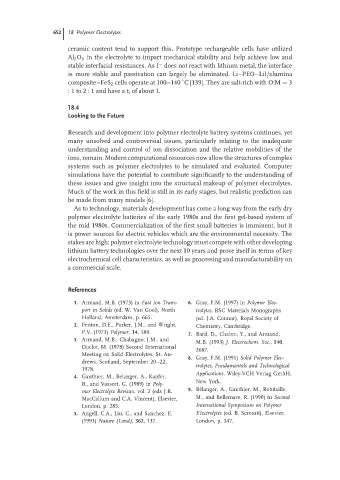Page 678 - Handbook of Battery Materials
P. 678
652 18 Polymer Electrolytes
ceramic content tend to support this. Prototype rechargeable cells have utilized
Al 2 O 3 in the electrolyte to impart mechanical stability and help achieve low and
−
stable interfacial resistances. As I does not react with lithium metal, the interface
is more stable and passivation can largely be eliminated. Li–PEO–LiI/alumina
◦
composite–FeS 2 cells operate at 100–140 C [139]. They are salt-rich with O:M = 3
:1to2:1and havea t i of about 1.
18.4
Looking to the Future
Research and development into polymer electrolyte battery systems continues, yet
many unsolved and controversial issues, particularly relating to the inadequate
understanding and control of ion dissociation and the relative mobilities of the
ions, remain. Modern computational resources now allow the structures of complex
systems such as polymer electrolytes to be simulated and evaluated. Computer
simulations have the potential to contribute significantly to the understanding of
these issues and give insight into the structural makeup of polymer electrolytes.
Much of the work in this field is still in its early stages, but realistic prediction can
be made from many models [6].
As to technology, materials development has come a long way from the early dry
polymer electrolyte batteries of the early 1980s and the first gel-based system of
the mid 1980s. Commercialization of the first small batteries is imminent, but it
is power sources for electric vehicles which are the environmental necessity. The
stakes are high: polymer electrolyte technology must compete with other developing
lithium battery technologies over the next 10 years and prove itself in terms of key
electrochemical cell characteristics, as well as processing and manufacturability on
a commercial scale.
References
1. Armand, M.B. (1973) in Fast Ion Trans- 6. Gray, F.M. (1997) in Polymer Elec-
port in Solids (ed. W. Van Gool), North trolytes, RSC Materials Monographs
Holland, Amsterdam, p. 665. (ed. J.A. Connor), Royal Society of
2. Fenton, D.E., Parker, J.M., and Wright, Chemistry, Cambridge.
P.V. (1973) Polymer, 14, 589. 7. Baril, D., Chabre, Y., and Armand,
3. Armand, M.B., Chabagno, J.M., and
M.B. (1993) J. Electrochem. Soc., 140,
Duclot, M. (1978) Second International 2687.
Meeting on Solid Electrolytes, St. An-
8. Gray, F.M. (1991) Solid Polymer Elec-
drews, Scotland, September 20–22, trolytes, Fundamentals and Technological
1978.
Applications, Wiley-VCH Verlag GmbH,
4. Gauthier, M., Belanger, A., Kapfer,
New York.
B., and Vassort, G. (1989) in Poly-
mer Electrolyte Reviews, vol. 2 (eds J.R. 9. B´ elanger, A., Gauthier, M., Robitaille,
MacCallum and C.A. Vincent), Elsevier, M., and Bellemare, R. (1990) in Second
London, p. 285. International Symposium on Polymer
5. Angell, C.A., Liu, C., and Sanchez, E. E1ectrolytes (ed. B. Scrosati), Elsevier,
(1993) Nature (Lond), 362, 137. London, p. 347.

